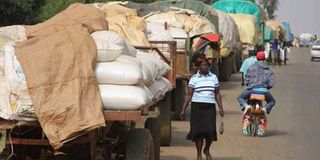Western Kenya hit by fall in maize production, experts say

Farmers deliver maize to the National Cereals and Produce Board, Eldoret deport. A drastic drop in maize production hit several parts of western Kenya last season, agriculture experts have said. FILE PHOTO | JARED NYATAYA | NATION MEDIA GROUP
What you need to know:
- Kakamega director of agriculture Johnson Imbila said production fell by over 50 per cent in the county alone.
- Busia County Agriculture executive Moses Osia said a significant portion of the crop had been completely destroyed.
- Poorly spread rains experienced last season made it difficult for maize to flower uniformly causing delay in formation of fruits.
- Access to subsidised agricultural inputs is also limited, according to Ms Imbalambala.
A drastic drop in maize production hit several parts of western Kenya last season, agriculture experts have said.
They have cited erratic weather, use of inappropriate fertilisers and outdated farming techniques as the main reasons farmers realised poor harvests last season.
Kakamega director of agriculture Johnson Imbila said production fell by over 50 per cent in the county alone.
“The second crop, usually planted during the short rains season, has also failed,” he said.
He said county governments must prioritise soil testing to help ascertain which particular nutrients are missing so that the required fertiliser is supplied to farmers in future.
Busia County Agriculture executive Moses Osia said a significant portion of the crop had been completely destroyed with the worst hit areas being Budalang’i and Funyula.
“We are taking the necessary steps as a county government to cushion locals from a possible food shortage,” he said.
The director of Rural Information on Agriculture and Development Centre Simon Wesechere said in some cases, farmers used wrong seeds.
POOR RAINS
He said poorly spread rains experienced last season made it difficult for maize to flower uniformly causing delay in formation of fruits.
“Unscrupulous businessmen also usually take advantage of planting seasons to sell fake seeds causing crop failure,” he said.
Kakamega County Agriculture minister Kulati Wangia said the region produces two million bags of maize annually against a demand of four million.
However, farmers have blamed their woes on absentee agriculture officials and unnecessary bureaucracy which they say has stalled plans to boost farming in the region.
Kakamega County Smallholder Farmers Network chairperson Alice Imbambala said farmers cannot easily access the multi-million shilling ploughing equipment purchased by the county in 2015.
Access to subsidised agricultural inputs is also limited, according to Ms Imbalambala.
“Only 15 per cent of smallholder farmers managed to get the services while the rest were not reached at all,” she said.
Governor Wycliffe Oparanya launched the Sh60 million tractors in all 12 sub-counties in February 2016 to reduce production costs.
Farmers were required to apply for the services through sub-county agricultural officers who would in turn vet and clear them after paying Sh2,000 per acre as ploughing charges.
Several farmers have started abandoning maize farming for sugarcane in Lugari and Likuyani sub-counties as a result of reducing yields, shooting costs of production and low prices offered for their produce.




